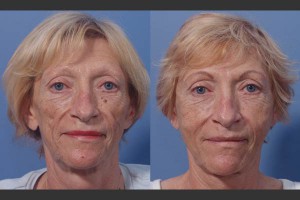Facial Fat Grafting for Volume Restoration

Fat grafting is the process of creating more volume within the tissues by removing fat from another part of the body and then putting that fat into the face or other volume deficient area to create a fuller, smoother appearance. Typically, a patient will notice a loss of fat volume around her jawline or under her eyes where the skin begins to show a more crepe-like appearance. To replenish this volume loss, fat can be gently removed from areas of the body with excess fatty deposits such as the abdomen or the thighs and introduced into those areas where it is lacking.
Through a tiny skin incision made in the fat donor area, a small liposuction cannula is used to harvest the excess fat. Once the fat deposits have been removed, the fatty tissue is purified of any contaminants or oils. Various growth factors, such as the patient’s own platelet rich plasma (PRP) can be added to the fat to increase its survival. The purified fat, with added growth factors, is then injected in the form of small droplets into the areas of the face that lack of volume. The patient’s own stem cells can also be derived from the liposuction retrieved fat for additional growth potential.
Before the procedure, patients are encouraged to meet with their doctor to discuss which areas of their face are of concern and which they hope to treat with a fat grafting session. Your doctor can help explain what to expect during the treatment process and while healing. Most patients will experience some mild bruising and swelling for up to a week following the procedure but this will resolve over several days and any pain associated with the procedure can be treated with anti-inflammatory medications or over the counter pain medications. More than one treatment session may be necessary. Results are often long-standing though they will vary among patients.

I had such a positive experience here with Dr. Z and his staff. From the initial consultation to my post-surgery appts. I couldn't have asked for a better experience. All my questions/concerns were addressed, the surgery itself went really well (and I am so happy with my results, seriously life changing), my recovery went smoothly and Dr. Z gave me his personal cell # so I could reach out if I had any worries during my recovery. Dr. Z and his staff truly care about their patients and go above and beyond to deliver the best results! I highly recommend coming here if you need any aesthetic surgery, you won't be disappointed.